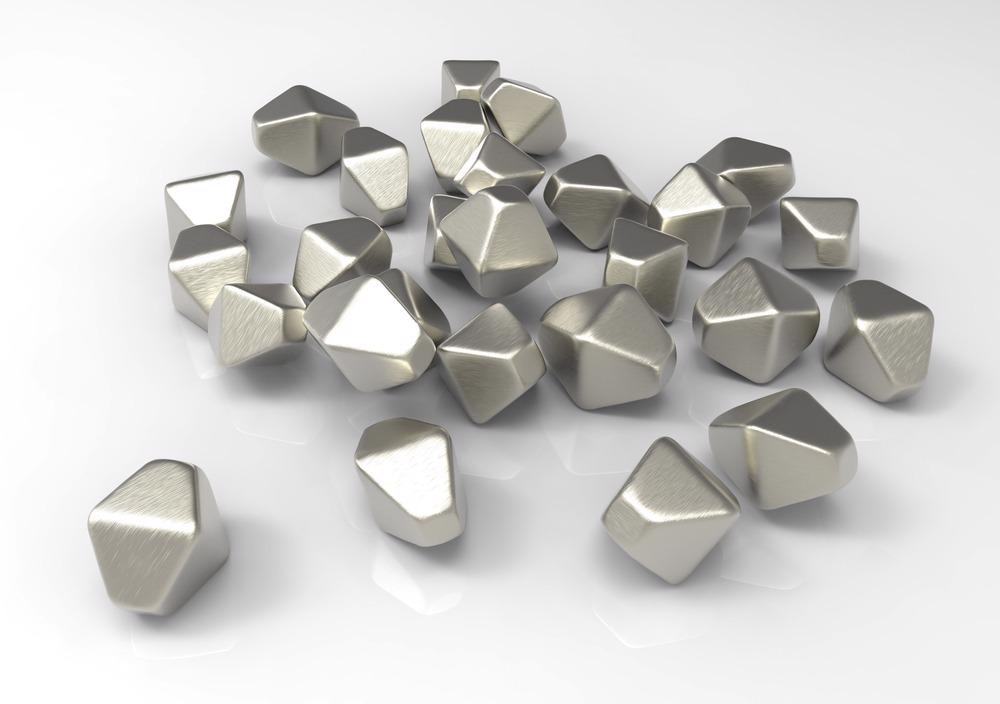Nanotechnology is the ground-breaking science and art of manipulating matter at the atomic or molecular scale, not only the size of tiny items. It is more about the structure and ability of molecular compounds to "function" than anything else and is a combination of top-down and bottom-up processes in particular. Nanoparticle technology's ultimate goal is to create goods with novel physical and chemical properties by creating atoms, molecules, and matter that present their properties directly in the length of a nanometre.

Image Credit: Kateryna Kon/ShutterStock.com
An Overview of Titanium Dioxide Nanoparticles
Titanium dioxide (TiO2) nanoparticles have a high refractive index (n = 2.4), making them ideal for various applications, including medicines, coatings, inks, plastics, food, cosmetics, and textiles.
Anatase (tetragonal), rutile (tetragonal), and brookite (orthorhombic) are the three crystalline phases of titanium dioxide. Typically, they are employed in the preparation of fabrics, windows, and anti-fogging automobile mirrors because of their self-cleaning and anti-fogging properties.
Titanium dioxide nanoparticles also act as a sanitizer for the environment.
Manufacturing TiO2 nanoparticles utilizes sol-gel, flame hydrolysis, co-precipitation, impregnation, and chemical vapor deposition processes. In particular, researchers are interested in the biosynthesis of titanium dioxide nanoparticles because it is a cost-effective, environmentally benign, and repeatable method.
The applications of titanium dioxide in the nanoparticles sector are very diverse. A few notable examples are discussed here in detail.
Video Credit: TDMA TitaniumDioxideManufacturersAssociation/YouTube.com
Applications of Titanium Dioxide Photocatalyst
Photocatalysis is the chemical reaction that occurs when light strikes a light-sensitive chemical molecule. When light contacts titanium dioxide, a chemical reaction occurs in the local area, causing organic poisons, smells, and other substances to be broken down. Use includes:
Environmental Improvement
TiO2 helps remove pollutants from the atmosphere, such as NO2 released by exhaust gas and other sources. In addition, SOx, a harmful inorganic substance in the atmosphere, can be broken down with TiO2.
Pharmaceutical Applications
Titanium dioxide photocatalyst often involves sterilization and virus restraint due to its ability to damage cell membranes, solidify virus proteins, control virus activation, and capture infectious particles. It has been shown to eliminate 99.97% of microorganisms.
Coliform, green suppuration bacillus, golden grape coccus, mildew, suppuration fungus, and other bacteria are examples of targets that TiO2 can kill. For example, studies have demonstrated the sterilizing ability of titanium dioxide using coliform and golden grape coccus; a population of 3.3105 coliforms and 3.2105 golden grape coccus were reduced to ten after 24 hours of reaction.
Waste Water Treatment
TiO2 nanoparticles are ideal for wastewater treatment because of their low cost, corrosion resistance, and overall stability. They can be used as solid-phase extraction (SPE) packing material to preconcentrate and extract heavy metals from water for surface water remediation.
Diazinon is an organophosphate insecticide that is found in groundwater and is classed as a relatively harmful toxin (Class II by the World Health Organization). Ultraviolet light and titanium dioxide (TiO2) nanoparticles doped with iron showed 98.58 % diazinon removal efficacy.
Additionally, TiO2 nanoparticles have a vital role in removing xenobiotic chemicals from wastewater, such as pesticides, dyes, and hazardous substances.

Image Credit: alicja neumiler/Shutterstock.com
Agricultural Applications of TiO2
TiO2 nanoparticles have been shown to boost the rate of photosynthesis in spinach crops. In other species, more pigmentation was detected in Zea mays sprayed with nano TiO2 during the reproductive stages of the plant, leading to increased crop production. When applied to tomato plants as an aerosol, TiO2 nanoparticles were found to be more effective at increasing photosynthesis and lycopene content than TiO2 nanoparticles used as a soil amendment.
Applications of Titanium Dioxide in the Medical Industry
Titanium dioxide has recently developed a number of different applications in the medical industry. Some of them are discussed here:
Drug Delivery Systems for Cancer Therapy
Traditional chemotherapy cancer treatment can have catastrophic effects on cells due to their toxic nature. As a result, the focus has been placed on how nanotechnology can be used to diagnose and treat cancer. Currently, the most significant challenge to overcome is reducing the side effects of nanotechnology-enabled drug systems.
Some strategies have shown promising results, involving controlling the amount of drugs released to the cell or targeting specific cells and delivering medications to them.
Antibacterial Devices for Infections
Many studies have shown that TiO2 has inhibitory activity due to photocatalytic action, which is mainly due to excessive production of highly reactive oxygen products (ROS) such as O2, OH, and H2O2. Because of its chemical and mechanical qualities, titanium is commonly used in dental implants. Long-term dental implant success hinges on infection control and the acquisition of new technology for implant placement in bone.
Usage in Long lasting Medical Implants
TiO2 nanostructures have been successfully used in essential medical products such as implants to address some of the topological issues around titanium implants. Deployment has been demonstrated in bone implants, dental implants, and other applications.
Future Challenges of Titanium Dioxide
In recent years, the primary usage of titanium dioxide nanostructures has been in cleaning the environment and creating hydrogen. Applying these nanostructured particles to the problems we face in real life is not easy, and limitations exist.
One of the biggest problems faced with these nanostructures is their efficiency, whilst other issues revolve around sensitivity and compatibility. However, research is addressing this sensitivity in visible and infrared regions by modifying synthetic routes.
Continue reading: The Role of Titanium Nanostructures in Biomedical Applications
References and Further Reading
Ali, I., Sohail, M., & A.Althoman, Z. (2018) Recent advances in syntheses, properties and applications of TiO2 nanostructures. RSC Advances(53). Available at: https://doi.org/10.1039/C8RA06517A
Baneshi, M., Rezaei.S, Sadat, A., Mousavizadeh, A., & Barafrashtehpour, M. (2017) Investigation of photocatalytic degradation of diazinon using titanium dioxide (TiO2) nanoparticles doped with iron in the presence of ultraviolet rays from the aqueous solution. Biosci Biotech Res Comm(10), 60-67. Available at: https://www.semanticscholar.org/paper/Investigation-of-photocatalytic-degradation-of-(-2-Baneshi-Rezaei/5e9181dbcb2db551cb83f8309ee953e28f7f1721
Jafari, S., Mahyad, B., Hashemzadeh, H., Janfaza, S., Gholikhani, T., & Tayebi, L. (2020) Biomedical Applications of TiO2 Nanostructures: Recent Advances. International Journal of Nanomedicine, 15, 3447-3470. Available at: https://doi.org/10.2147/IJN.S249441
Waghmode, M. S., Gunja, A. B., Mulla, ·. J., Patil, N. N., & Nawani, N. N. (2019) Studies on the titanium dioxide nanoparticles: biosynthesis, applications and remediation. Springer Nature Switzerland AG. Available at: https://doi.org/10.1007/s42452-019-0337-3
Ziental, D., Czarczynska-Goslinska, B., Mlynarczyk, D. T., Glowacka-Sobotta, A., Stanisz, B., Goslinski, T., & Sobotta, L. (2020) Titanium Dioxide Nanoparticles: Prospects and Applications in Medicine. Nanomaterials, 10(2), 387. Available at: https://doi.org/10.3390/nano10020387
Disclaimer: The views expressed here are those of the author expressed in their private capacity and do not necessarily represent the views of AZoM.com Limited T/A AZoNetwork the owner and operator of this website. This disclaimer forms part of the Terms and conditions of use of this website.